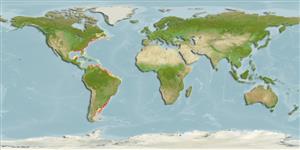Common names from other countries
Classification / Names / Names
ماع يماسا | فدارتم | Catalog of Fishes (gen., sp.) | ITIS | CoL | WoRMS
Environment: milieu / climate zone / depth range / distribution range
يسانش موب
; روش بل; قمع تارييغت 0 - 43 m (Ref. 108755). Temperate
Eastern Pacific and Western Atlantic: North America, Canada to Brazil.
Length at first maturity / Size / Weight / نس
Maturity: Lm ?, range 0 - 0.55 cm Max length : 2.0 cm CW يسنج صاوخ نودب / رن سنج; (Ref. 79470); هدش شرازگ نس هنيشيب: 2.00 اه لاس (Ref. 109497)
Euryhaline. Prefers brackish waters, found in estuaries or quasi-freshwater lakes. Lives in muddy or sandy substrates, as well as on oyster reefs, vegetation, logs and manmade debris (Ref. 108786). Also on rubble (Ref. 97531). Omnivorous scavenger (Ref. 108786).
Life cycle: It undergoes four (4) zoeal stages and one (1) megalopa before turning into adult (Refs. 79470, 109437, 109442, 109461). Mating behavior: Precopulatory courtship ritual is common (through olfactory and tactile cues); usually indirect sperm transfer (Ref. 833). Spawning occurs from July to August in northern latitudes, April to September in mid latitudes, and April to November in southern latitudes (Ref. 109493). Females burrow in the sand to lay eggs prior to copulation, brooding takes 15-19 days (Ref. 109502).
یلصا ذخآم
عجارم | هدننك گنهامه | ناراكمه
Hill, M., R. Baker, G. Broad, P.J. Chandler, G.H. Coop, J. Ellis, D. Jones, C. Hoyland, I. Laing, M. Longshaw, N. Moore, D. Parrott, D. Pearman, C. Preston, R.M. Smith and R. Waters. 2005. (Ref. 1314)
NCUI زمرق تسرهف رد تيعضو (Ref. 130435)
ستياس رظن زا تيعضو (Ref. 108899)
Not Evaluated
Not Evaluated
یناسنا هدافتسا
| FishSource |
اهرازبا
يتنرتنيا عبانم
Estimates based on models
Preferred temperature
(Ref.
115969): 7.2 - 22.9, mean 14.2 (based on 234 cells).
یگدنهج
دايز, هام 51 زا رتمك ، تيعمج ندش ربارب ود يارب مزال نامز هنيمك (K=1.28; tmax=2).
تميق هقبط
Unknown.
